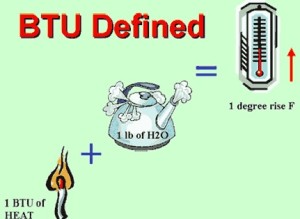British Thermal Unit (BTU) is defined as the quantity of heat required to raise the temperature of a pound of water one degree Fahrenheit. It is the basic measure of heat energy used in the Imperial system. When you understand the number of BTUs you require per square foot of your space, you will have an easy time in choosing the correct size of an AC system or a furnace for effective cooling and heating your home.
Determining the Heating or Cooling Needs
 The first step in the determination of the BTUs you need is to calculate the space to be heated or cooled. If your rooms are triangular, rectangular or any other definite shape, all you need is to calculate the area. However, in the event your room does not have a definite shape, you must divide it into spaces that take regular shapes. Use the geometric formulas to calculate the areas. Rectangles = length x width; Triangles = 0.5 x base x height; circles = 3.14 x the square of the radius. Thereafter, add all the areas to find the total square footage. Basement, upstairs and attic rooms should be included if you have ductwork running to these floors.
The first step in the determination of the BTUs you need is to calculate the space to be heated or cooled. If your rooms are triangular, rectangular or any other definite shape, all you need is to calculate the area. However, in the event your room does not have a definite shape, you must divide it into spaces that take regular shapes. Use the geometric formulas to calculate the areas. Rectangles = length x width; Triangles = 0.5 x base x height; circles = 3.14 x the square of the radius. Thereafter, add all the areas to find the total square footage. Basement, upstairs and attic rooms should be included if you have ductwork running to these floors.
Since the capacity of ACs and furnaces are expressed in BTUs per hour, you must establish the number of BTUs per square foot you need for your home heating and cooling. The simplest formula includes multiplication of your total square footage by 20 BTUs per square foot.
Example: If your square footage is 1000, the BTUs you need are;
20 x 1000 = 20,000
However, this formula does not factor in the amount of insulation in your home, the way you live and the surrounding climate.
Establishing the Correct Heating Capacity
Depending on where you live, the BTUs per square footage you require vary. Warmer climates need only 30 to 35 BTUs for every square foot while colder climates require 50 to 60 BTUs. In short, the warmer the climate the fewer the BTUs you need and vice versa. To determine your climate zone, you can check the United States map here.
The age and insulation of your home is also a factor you must consider. By design, newer homes have better insulation than older homes due to building code revisions over the years. Well insulated homes have fewer BTU needs per square foot compared to older homes. In warm climates, new homes require about 30 BTUs while old homes need 35 BTUs. In cold climates, new homes require 50 BTUs while old homes on the other hand require 60 BTUs.
Having determined the climate you live in and the nature of your home, you can easily calculate the heating capacity of the furnace or heat pump you require. For instance, if your house has a square footage of 2,500 and the climatic zone you live in has a heating factor of 30 BTUs per square foot, the output of the furnace you need to install is determined as:
Square footage x heating factor;
2,500 x 30 = 75,000 BTUs per hour btu calculator can help you in this task
The efficiency rating of your furnace is a very critical variable. Remember furnaces are rated by the amount of heat generated and not by the actual BTU output. The heat input vis-à-vis the heat output is what determines the efficiency of a furnace and is expressed as a percentage of the heat output. Following the example above, purchasing a 75,000 BTUs per hour input furnace is not sufficient to meet the needs. You need to look at the efficiency rating. Where the efficiency is 80 percent, the heat output will be 60,000 BTUs per hour. For the same efficiency rating, you require a furnace with a BTU per hour rate of 93,750.
Determining the Appropriate Cooling Capacity
If you are purchasing a room air conditioner, all you need is to figure out the square footage of the room where it will be installed. On the other hand, if you are buying a heat pump or central air conditioner, you have to calculate the entire square footage covered by the ductwork. The Energy Star index can help you to determine the cooling capacity of the AC you need.
In case you are purchasing a room AC, you need to adjust your needs. If the room to be cooled is shaded, reduce the AC capacity by about 10 percent and where the room to be cooled is very sunny; enhance the necessary capacity by 10 percent. In a room that regularly host above two people, consider adding 600 BTUs for every person from the third onwards.
Air conditioners are rated by their efficiency in using electricity over a typical operating year. One of the commonly used ratings is Seasonal Energy Efficiency Ratio (SEER). This rating refers to; the ratio of the AC’s cooling output (BTUs) divided by the energy (watt-hours) required to run it the entire year. For instance, a 4,000 BTU per hour AC running for 1,000 hours in an operating year and using 400,000 watt-hours of electricity during the same period has a SEER rating as calculated below:
(BTU output per hour x operating hours) / Watt-hours;
4,000 x 1,000 / 400,000 = 10 SEER
As from 1st January 2015, heat pumps and AC systems are required to have a minimum SEER rating of 14 in order to be Energy Star Qualified.

